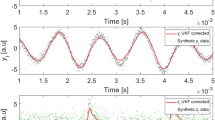Abstract
Topology identification of complex networks is an important problem. Existing research shows that the synchronization of network nodes is an obstacle in the identification of network topology. Identification of the structure of the network presents an interesting challenge during the synchronization of complex networks. We developed a new method using the sinusoidal disturbance to identify the topology when the complex network achieves synchronization. Compared with the disturbance of all the nodes, the disturbance of the key nodes alone can achieve a very good effect. Finally, numerical simulation data are provided to validate our hypothesis.
概要
中文概要
拓扑识别是近年来复杂网络研究的重要问题, 研究表明, 网络上节点同步是拓扑识别过程中的重要障碍. 当节点到达同步时如何进行识别是一个非常有趣的问题. 本文主要研究了节点为Hindmarsh-Rose (HR) 系统的网络结构识别问题, 当网络上HR系统达到同步时, 它们不满足一致激励条件, 拓扑结构不能识别. 此时, 正弦信号扰动能够诱导拓扑识别. 相比于扰动网络上全部节点, 扰动关键节点也能达到拓扑识别的目的.
创新点
拓扑识别问题是复杂网络研究的重要问题, 研究结果表明, 当网络上的节点达到同步时候, 拓扑很难识别. 利用正弦扰动信号, 本文研究了当节点达到同步状态时的拓扑识别问题, 研究表明给节点添加适当的正弦扰动能够诱导出拓扑识别.
Similar content being viewed by others
References
Watts D J, Strogatz S H. Collective dynamics of ‘small-world’ networks. Nature, 1998, 391: 440–442
Barabasi A L, Albert R. Emergence of scaling in random networks. Science, 1999, 286: 509–512
Pecora L M, Carroll T L. Master stability function for synchronized coupled systems. Phys Rev Lett, 1998, 80: 2109–2112
Belykh V N, Belykh I V, Hasler M. Connection graph stability method for synchronized coupled chaotic systems. Phys D, 2004, 195: 159–187
Belykh I V, Belykh V N, Hasler M. Generalized connection graph method for synchronization in asymmetrical networks. Phys D, 2006, 224: 42–51
Lu J, Cao J D. Synchronization-based approach for parameters identification in delayed chaotic neural networks. Phys A, 2007, 382: 672–682
Chen L, Lu J, Tse C K. Synchronization: an obstacle to identification of network topology. IEEE Trans Circ Syst-II, 2009, 56: 310–314
Zhao J C, Li Q, Lu J A, et al. Topology identification of complex dynamical networks. Chaos, 2010, 20: 023119
Ren J, Wang W, Li B, et al. Noise bridges dynamical correlation and topology in coupled oscillator networks. Phys Rev Lett, 2010, 104: 058701
Wu X Q, Wang W H, Zheng W X. Inferring topologies of complex networks with hidden variables. Phys Rev E, 2012, 86: 046106
Zhang S N, Wu X Q, Lu J A, et al. Recovering structures of complex dynamical networks based on generalized outer synchronization. IEEE Trans Circ_Syst I, 2014, 61: 3216–3224
Li G J, Wu X Q, Liu J, et al. Recovering network topologies via Taylor expansion and compressive sensing. Chaos, 2015, 25: 043102
Wu X Q, Zhao X Y, Lü J H, et al. Identifying topologies of complex dynamical networks with stochastic perturbations. IEEE Trans Control Netw Syst, 2015, 21: 1–10
Mukeshwar D, Jirsa V, Ding M. Enhancement of neural synchrony by time delay. Phys Rev Lett, 2004, 92: 074104
Wang Z, Shi X. Lag synchronization of multiple identical Hindmarsh-Rose neuron models coupled in a ring structure. Nonlinear Dyn, 2010, 60: 375–383
Jia C, Wang J, Deng B, et al. Estimating and adjusting abnormal networks with unknown parameters and topology. Chaos, 2011, 21: 013109
Ehrich S, Pikovsky A, Rosenblum M. From complete to modulated synchrony in networks of identical Hindmarsh-Rose neurons. Eur Phys J Spec Top, 2013, 222: 2407–2416
Li C H, Yang S Y. Effects of network structure on the synchronizability of nonlinearly coupled Hindmarsh-Rose neurons. Phys Lett A, 2015, 379: 2541–2548
Li X, Wang X F, Chen G R. Pinning a complex dynamical network to its equilibrium. IEEE Trans Circ Syst I, 2004, 51: 2074–2087
Chen T, Liu X, Lu W. Pinning complex networks by a single controller. IEEE Trans Circ Syst I, 2007, 54: 1317–1326
Yu W W, Chen G R, Lü J H. On pinning synchronization of complex dynamical networks. Automatica, 2009, 45: 429–435
Xiang L Y, Liu Z X, Chen Z Q, et al. Pinning weighted complex networks with heterogeneous delays by a small number of feedback controllers. Sci China Ser F-Inf Sci, 2008, 51: 511–523
Zhao J C, Lu J A, Wu X Q. Pinning control of general complex dynamical networks with optimization. Sci China Inf Sci, 2010, 53: 813–822
Zheng C, Cao J. Robust synchronization of coupled neural networks with mixed delays and uncertain parameters by intermittent pinning control. Neurocomputing, 2014, 141: 153–159
Hodgkin A L, Huxley A F. A quantitative description of membrane current and its application to conduction and excitation in nerve. J Phys, 1952, 117: 500–544
Hindmarsh J L, Rose R M. A model of the nerve impulse using two first-order differential equations. Nature, 1982, 296: 162–164
Hindmarsh J L, Rose R M. A model of neuronal bursting using three coupled first order differential equations. Proc Royal Soc London, 1984, 221: 87–102
Corson N, Aziz-Alaoui M A. Asymptotic dynamics for slow-fast Hindmarsh-Rose neuronal system, dynamics of continuous. Discrete Impulsive Syst Ser, 2009, 16: 535–549
Corson N, Aziz-Alaoui M A. Ghnemat R, et al. Modelling the dynamics of complex interaction systems: from morphogenesis to control. Int J Bifurcation Chaos, 2012, 51: 112–120
Khalil H. Nonlinear Systems. 2nd ed. Englewood Cliffs: Prentice Hall, 1996
Sastry S, Bodson M. Adaptive Control-Stability, Convergence, and Robustness. Englewood Cliffs: Prentice Hall, 1989
Lu W L, Chen T P, Chen G R. Synchronization analysis of linearly coupled systems described by differential equations with a coupling delay. Phys D, 2006, 221, 118–134
Besançon G. Remarks on nonlinear adaptive observer design. Syst Control Lett, 2000, 41: 271–280
Author information
Authors and Affiliations
Corresponding author
Rights and permissions
About this article
Cite this article
Zhao, J., Aziz-Alaoui, M.A., Bertelle, C. et al. Sinusoidal disturbance induced topology identification of Hindmarsh-Rose neural networks. Sci. China Inf. Sci. 59, 112205 (2016). https://doi.org/10.1007/s11432-015-0915-9
Received:
Accepted:
Published:
DOI: https://doi.org/10.1007/s11432-015-0915-9
Keywords
- complex network
- topology identification
- sinusoidal disturbance
- persistently exciting condition
- Hindmarsh-Rose system




